engine OLDSMOBILE CUTLASS 1997 Repair Manual
[x] Cancel search | Manufacturer: OLDSMOBILE, Model Year: 1997, Model line: CUTLASS, Model: OLDSMOBILE CUTLASS 1997Pages: 353, PDF Size: 16.72 MB
Page 240 of 353
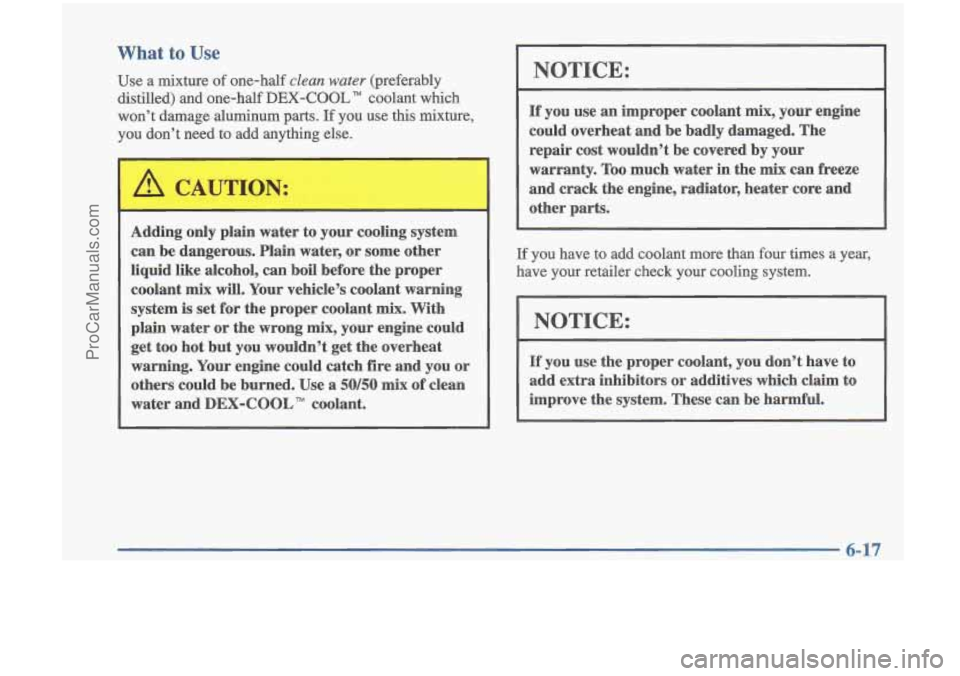
What to Use
Use a mixture of one-half clean water (preferably
distilled) and one-half
DEX-COOL” coolant which
won’t damage aluminum parts. If you use this mixture,
you don’t need to add anything else.
Adding only plain water to your cooling system
can be dangerous. Plain water, or some other
liquid like alcohol, can boil before the proper
coolant
mix will. Your vehicle’s coolant warning
system is set for the proper coolant mix. With
plain water or the wrong
mix, your engine could
get too hot but you wouldn’t get the overheat
warning. Your engine could catch fire and you or
others could be burned. Use a
50/50 mix of clean
water and
DEX-COOL TM coolant.
NOTICE:
If you use an improper coolant mix, your engine
could overheat and be badly damaged. The
repair cost wouldn’t be covered by your
warranty.
Too much water in the mix can freeze
and crack the engine, radiator, heater core and
other parts.
If you have to add coolant more than four times a year,
have your retailer check your cooling system.
NOTICE:
I I
If you use the proper coolant, you don’t have to
add extra inhibitors or additives which claim to
improve the system. These can be harmful.
ProCarManuals.com
Page 241 of 353
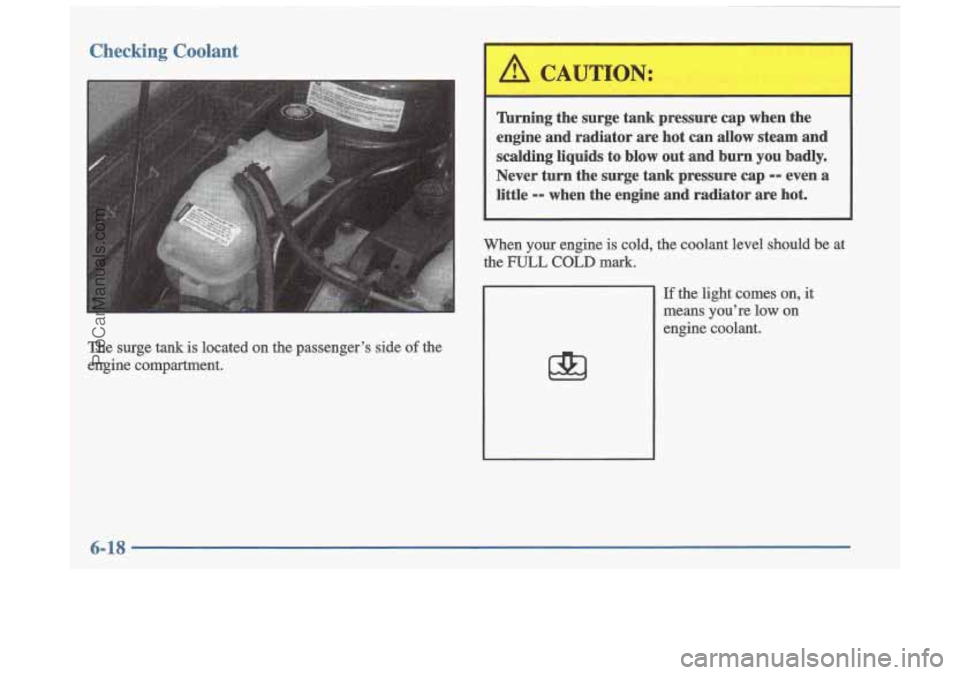
Checking Coolant
The surge tank is located on the passenger’s side of the
engine compartment.
Turning the surge tank pressure cap when the
engine and radiator are hot can allow steam and
scalding liquids to blow out and
burn you badly.
Never turn the surge tank pressure cap
-- even a
little
-- when the engine and radiator are hot.
When your engine is cold, the coolant level should be at
the
FULL COLD mark.
If the light comes on, it
means you’re low on
engine coolant.
ProCarManuals.com
Page 243 of 353
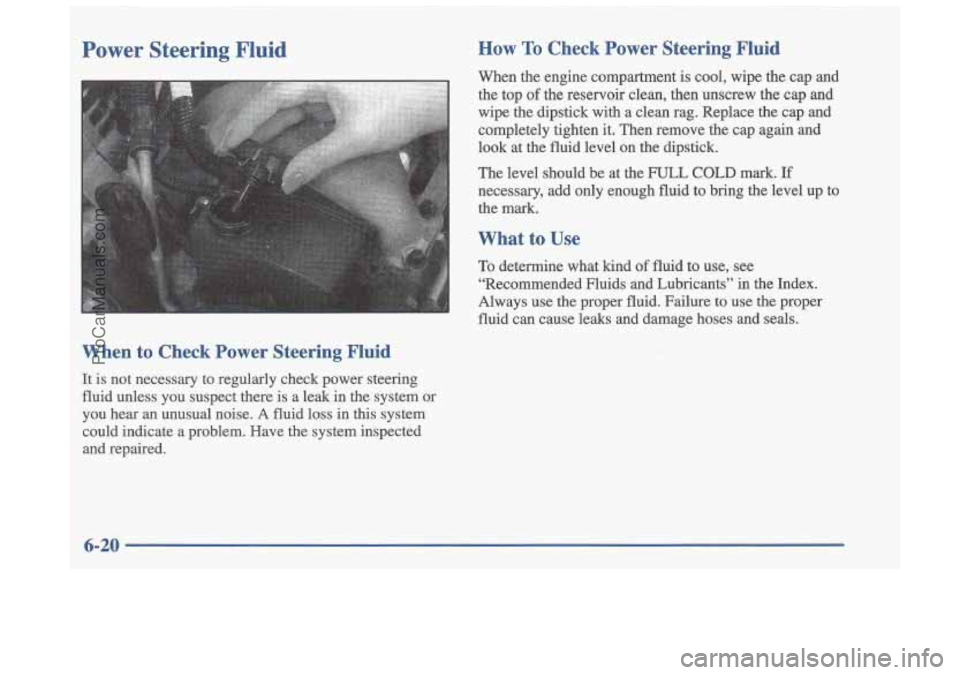
Power Steering Fluid
When to Check Power Steering Fluid
It is not necessary to regularly check power steering
fluid unless you suspect there
is a leak in the system or
you hear an unusual noise.
A fluid loss in this system
could indicate a problem. Have the system inspected and repaired.
How To Check Power Steering Fluid
When the engine compartment is cool, wipe the cap and
the top
of the reservoir clean, then unscrew the cap and
wipe the dipstick with a clean rag. Replace the cap and
completely tighten it. Then remove the cap again and
look at the fluid level on the dipstick.
The level should be at the
FULL COLD mark. If
necessary, add only enough fluid to bring the level up to
the mark.
What to Use
To determine what kind of fluid to use, see
“Recommended Huids and Lubricants” in the Index.
Always use the proper fluid. Failure to use the proper
fluid can cause leaks and damage hoses and seals.
6-20
ProCarManuals.com
Page 245 of 353
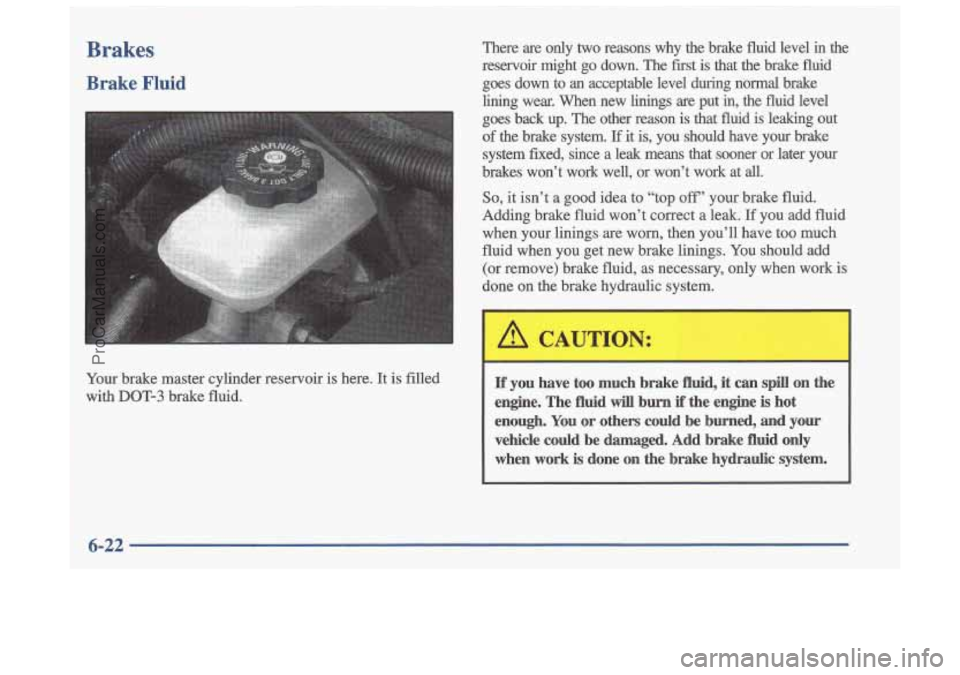
Brakes
Brake Fluid
Your brake master cylinder reservoir is here. It is filled
with
DOT-3 brake fluid. There are only
two reasons why the brake fluid level in the
reservoir might go down. The first is that the brake fluid
goes down to
an acceptable level during normal brake
lining wear. When new linings are put in, the fluid level
goes back up. The other reason
is that fluid is leaking out
of the brake system. If it is, you should have your brake
system. fixed, since a leak means that sooner or later your
brakes won’t work well, or won’t work at
all.
So, it isn’t a good idea to “top off’ your brake fluid.
Adding brake fluid won’t correct
a leak. If you add fluid
when your linings are
worn, then you’ll have too much
fluid when
you get new brake linings. You should add
(or remove) brake fluid, as necessary, only when work is
done on the brake hydraulic system.
If you have too much brake fluid, it can spill on the
engine.
The fluid will burn if the engine is hot
enough.
You or others could be burned, and your
vehicle could be damaged. Add brake fluid only when work
is done on the brake hydraulic system.
6-22
ProCarManuals.com
Page 246 of 353
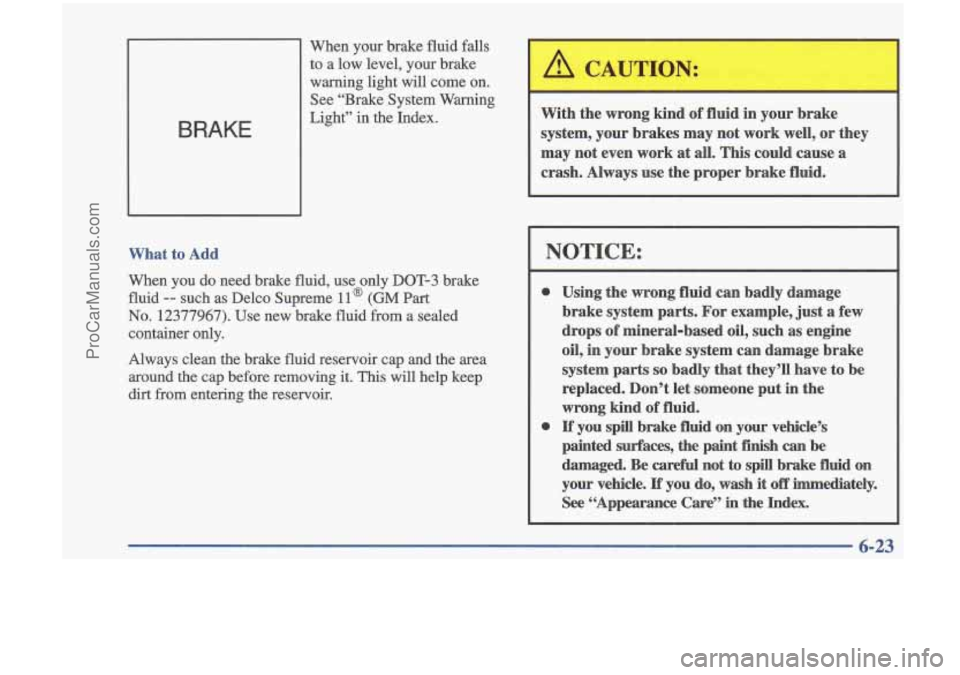
1
When your brake fluid falls to a low level, your brake
warning light will come on.
See “Brake System Warning
What to Add
When you do need brake fluid, use only DOT-3 brake
fluid
-- such as Delco Supreme ll@ (GM Part
No. 12377967). Use new brake fluid from a sealed
container only.
Always clean the brake fluid reservoir cap and the area
around the cap before removing
it. This will help keep
dirt from entering the reservoir.
With the wrong kind of fluid in your brake
system, your brakes may not work
well, or they
may not even work
at all. This could cause a
crash. Always use the proper brake fluid.
NOTICE:
a
a
Using the wrong fluid can badly damage
brake system parts. For example, just a few
drops
of mineral-based oil, such as engine
oil, in your brake system can damage brake
system parts
so badly that they’ll have to be
replaced. Don’t let someone put in the
wrong kind
of fluid.
If you spill brake fluid on your vehicle’s
painted surfaces, the paint finish
can be
damaged. Be
careful not to spill brake fluid on
your vehicle.
If you do, wash it off immediately.
See “Appearance Care” in the Index.
6-23
ProCarManuals.com
Page 248 of 353
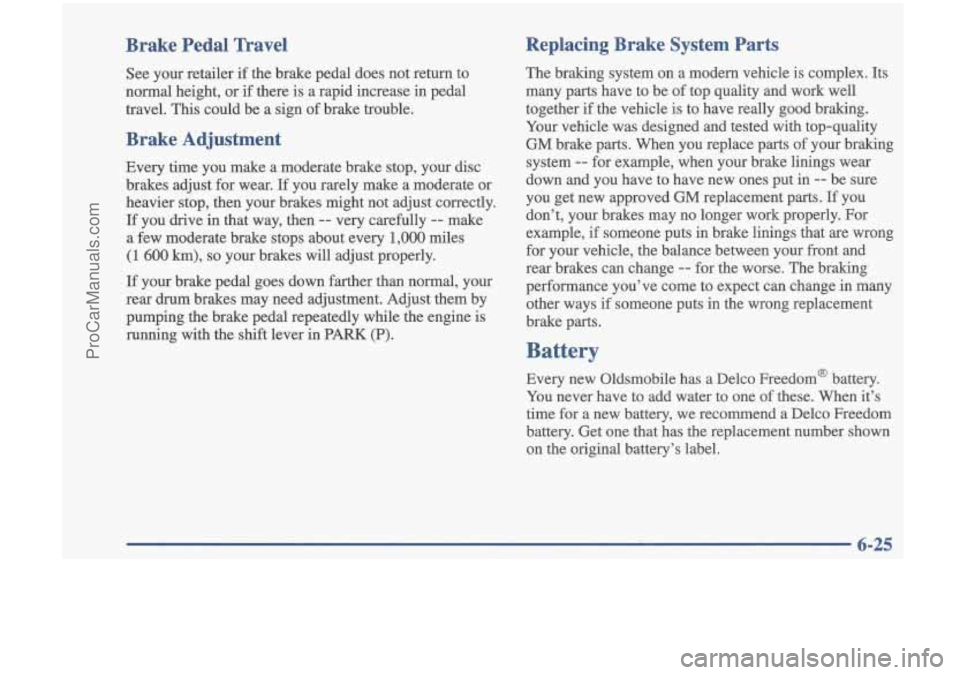
Brake Pedal Travel Replacing Brake System Parts
See your retailer if the
brake pedal does not return to
normal height, or if there is a rapid increase in pedal
travel. This could be a sign of brake trouble.
Brake Adjustment
Every time you make a moderate brake stop, your disc
brakes adjust for wear.
If you rarely make a moderate or
heavier stop, then your brakes might not adjust correctly.
If you drive in that way, then -- very carefully -- make
a few moderate brake stops about every
1,000 miles
(1 600 h), so your brakes will adjust properly.
If your brake pedal goes down farther than normal, your
rear drum brakes may need adjustment. Adjust them by
pumping the brake pedal repeatedly while the engine is
running with the shift lever in
PARK (P).
The braking system on a modern vehicle is complex. Its
many parts have to be of top quality and work well
together if the vehicle is to have really good braking.
Your vehicle was designed and tested with top-quality
GM brake parts. When you replace parts of your braking
system
-- for example, when your brake linings wear
down and you have to have new ones put in
-- be sure
you get new approved GM replacement parts.
If you
don’t, your brakes may no longer work properly. For
example, if someone puts in brake linings that are wrong
for your vehicle, the balance between your front and
rear brakes can change
-- for the worse. The braking
performance you’ve come to expect can change in many
other ways if someone puts in the wrong replacement
brake parts.
Battery
Every new Oldsmobile has a Delco Freedom@ battery.
You never have to add water to one of these. When it’s
time for a new battery, we recommend a Delco Freedom
battery. Get one that has the replacement number shown
on the original battery’s label.
6-25
ProCarManuals.com
Page 250 of 353
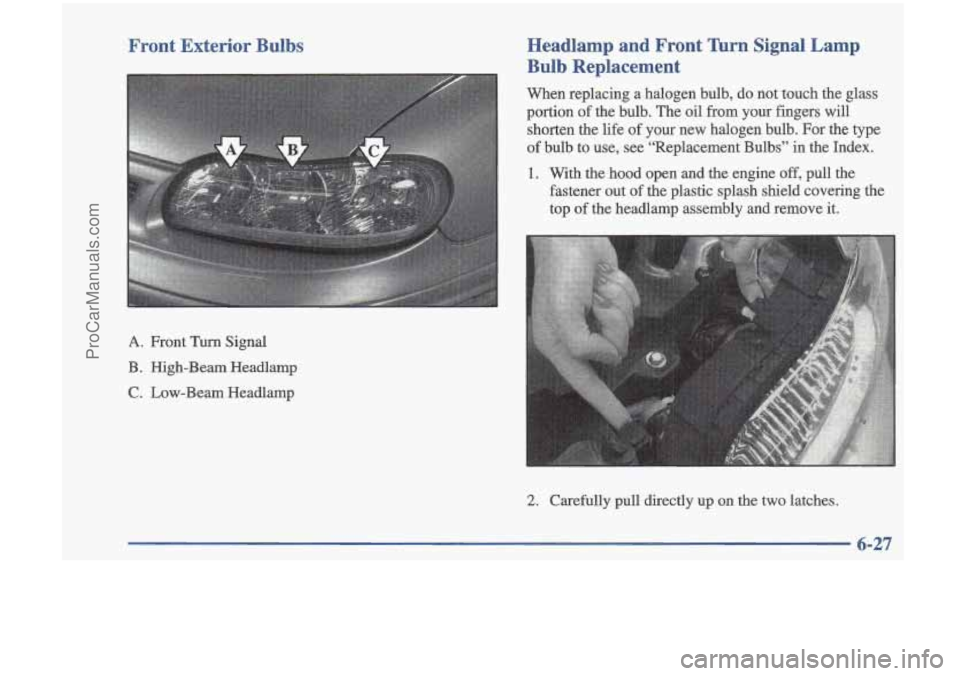
Front Exterior Bulbs
A
Headlamp and Front Wrn Signal Lamp
Bulb Replacement
When replacing a halogen bulb, do not touch the glass
portion of the bulb. The
oil from your fingers will
shorten the life of
your new halogen bulb. For the type
of bulb to use, see “Replacement Bulbs” in the Index.
I
1. With the hood open and the engine off, pull the
fastener out
of the plastic splash shield covering the
top of the headlamp assembly and remove it.
A. Front Turn Signal
B. High-Beam Headlamp
C. Low-Beam Headlamp
2. Carefully pull directly up on the two latches.
6-27
ProCarManuals.com
Page 272 of 353
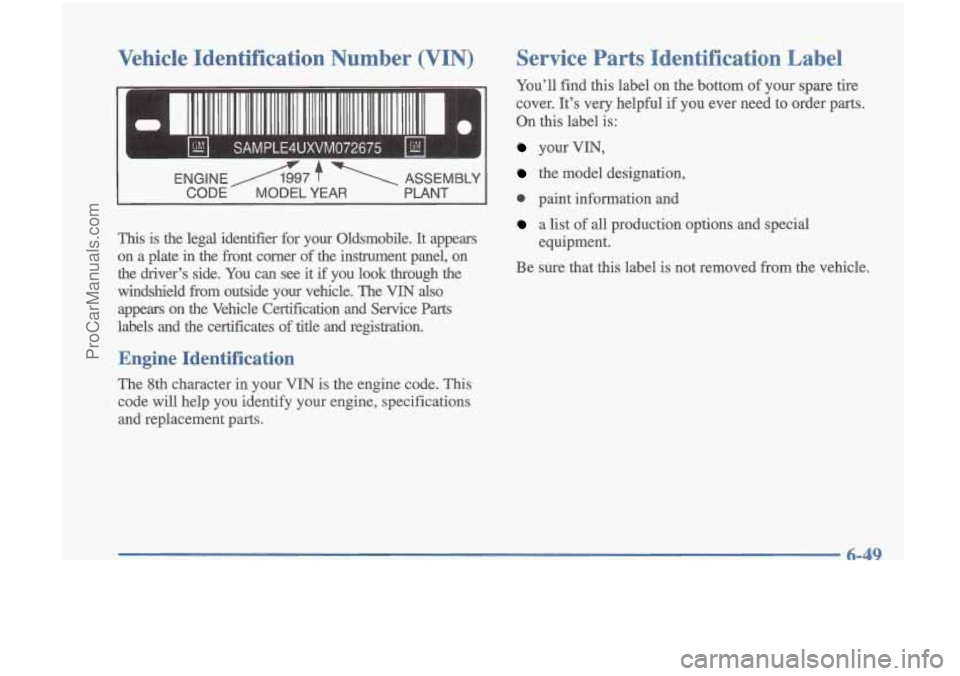
Vehicle Identification Number (VIN)
ENGINE A7 f ASSEMBLY
CODE MODEL YEAR PLANT
This is the legal identifier for your Oldsmobile. It appears
on a plate in the front corner
of the instrument panel, on
the driver’s side. You can see it
if you look through the
windshield from outside your vehicle. The
VIN also
appears on the Vehicle Certification and SerVice Parts
labels and the certificates of title and registration.
Engine Identification
The 8th character in your VIN is the engine code. This
code will help you identify your engine, specifications
and replacement parts.
Service Parts Identification Label
You’ll find this label on the bottom of your spare tire
cover. It’s very helpfbl
if you ever need to order parts.
On this label
is:
your VIN,
the model designation,
0 paint information and
a list of all production options and special
equipment.
Be sure that this label is not removed from the vehicle.
6-49
ProCarManuals.com
Page 274 of 353
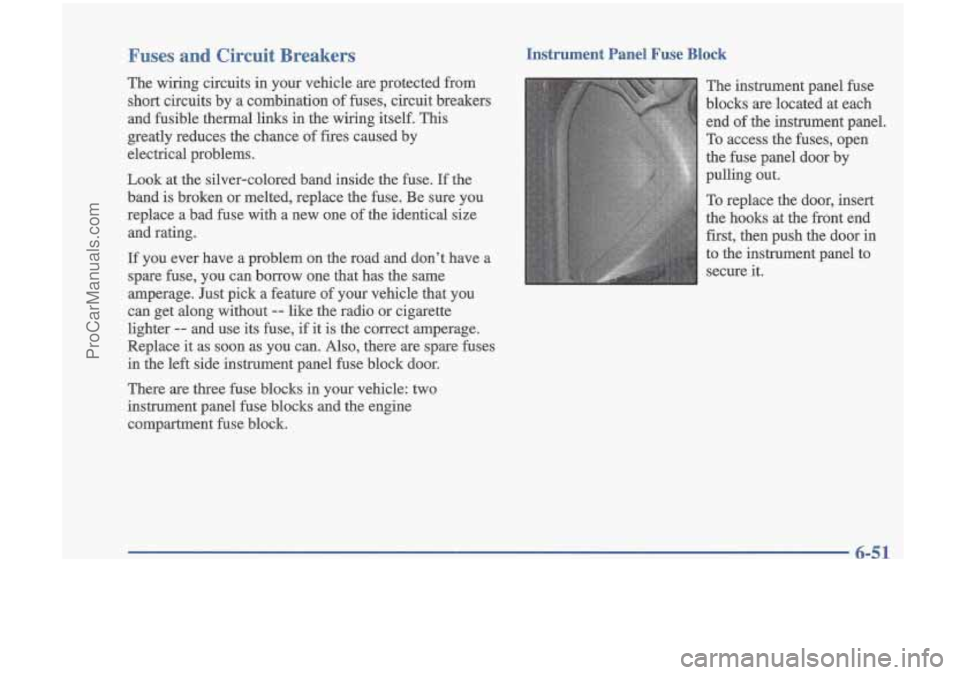
Fuses and Circuit Breakers
The wiring circuits in your vehicle are protected from
short circuits by a combination of fuses, circuit breakers
and fusible thermal links in the wiring itself.
This
greatly reduces the chance of fires caused by
electrical problems.
Look at the silver-colored band inside the fuse.
If the
band is broken or melted, replace the fuse. Be sure you
replace a bad fuse with a new one of the identical size
and rating.
If you ever have a problem on the road and don’t have a
spare fuse, you can borrow one that has the same
amperage. Just pick a feature of your vehicle that you
can get along without
-- like the radio or cigarette
lighter
-- and use its fuse, if it is the correct amperage.
Replace it as soon as you can. Also, there are spare fuses
in the left side instrument panel fuse block door.
There are three fuse blocks in your vehicle: two
instrument panel fuse blocks and the engine
compartment fuse block.
Instrument Panel Fuse Block
The instrument panel fuse
blocks are located at each end
of the instrument panel.
To access the fuses, open
the fuse panel door by
pulling out.
To replace the door, insert
the hooks at the front end
first, then push the door in
to the instrument panel to secure it.
ProCarManuals.com
Page 277 of 353
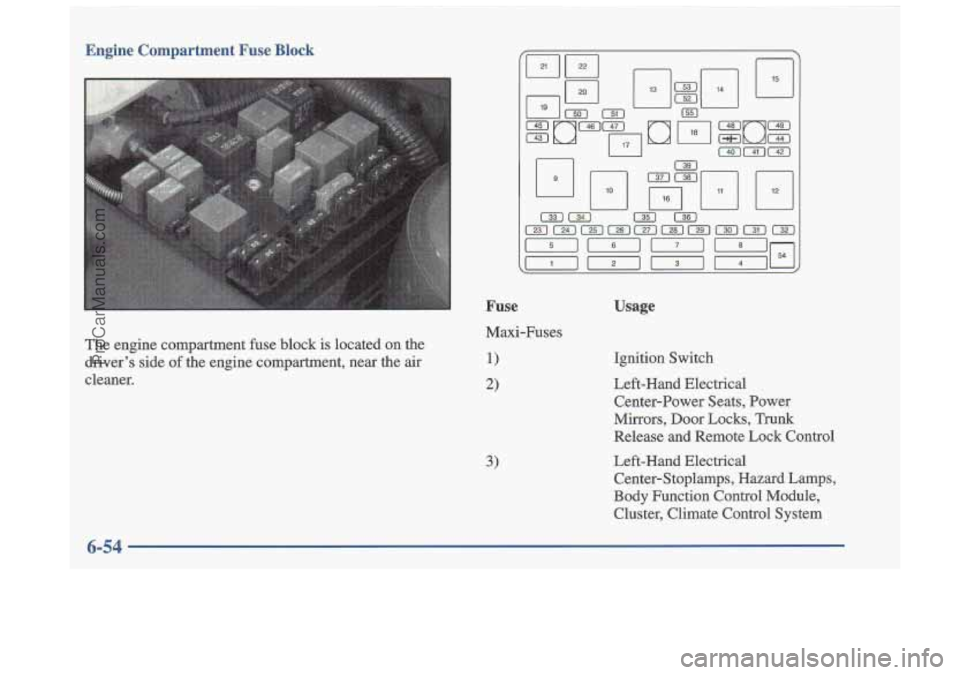
Engine Compartment Fuse Block
The engine compartment fuse block is located on the
driver's side
of the engine compartment, near the air
cleaner.
F nn
Fuse
Maxi-Fuses
1)
2)
3)
Usage
Ignition Switch
Left-Hand Electrical
Center-Power Seats, Power
Mirrors, Door Locks,
Trunk
Release and Remote Lock Control
Left-Hand Electrical Center-Stoplamps, Hazard Lamps,
Body Function Control Module,
Cluster, Climate Control System
6-54
ProCarManuals.com